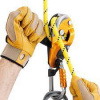Rope Access: Difference between revisions
SMacluskie (talk | contribs) No edit summary |
SMacluskie (talk | contribs) No edit summary |
||
| Line 29: | Line 29: | ||
: This is attached to your middle cowstail and helps you get up ropes. It is in essence a croll attached to a handle with a footloop attached on the bottom. | : This is attached to your middle cowstail and helps you get up ropes. It is in essence a croll attached to a handle with a footloop attached on the bottom. | ||
* [[Image: | * [[Image:Rig.jpg|100px]] A Descending Device (Down Gear) | ||
: This enables you | : This is aPetzl Rig. It enables you to descend in a safe, controlled manner. It is attached using a karabiner onto your belt and it is vital you understand how to thread it up correctly before attempting to thread it up at height. | ||
* [[Image:petzl_ID.jpg|100px]] ID (Down Gear) | * [[Image:petzl_ID.jpg|100px]] ID (Down Gear) | ||
: | :This is Petzl ID. Slightly larger than the Rig with an autolock function should you try to descent too quickly. | ||
* [[Image:MGO_Hooks.jpg|100px]] MGO Hooks and Shock Absorbing Lanyards | * [[Image:MGO_Hooks.jpg|100px]] MGO Hooks and Shock Absorbing Lanyards | ||
Revision as of 13:52, 25 August 2021

THESE NOTES ARE ONLY FOR INFORMATION. IF YOU HAVE NOT BEEN FULLY TRAINED IN ROPE ACCESS (THINK IRATA), DON’T DO IT! THERE IS GREAT POTENTIAL TO CAUSE INJURY IF ATTEMPTED INCORRECTLY.
In the words of Q – “Always have an escape plan”. Before we start to do anything at height we must have a rescue plan, a method statement (approved code of practice), and a risk assessment. Rope access should only take place when an IRATA trained member of staff is present (currently only Steve & Malcolm).
The Equipment
The equipment we require for rope access is fairly extensive and specialised. The good thing about it is that if used properly it is highly unlikely to fail (most accidents are caused by user error). We require –
- 2x Ropes
- You need 2 static lines (NOT climbing ropes), on separate anchor points.
- This is heavier duty and bulkier than your average fall arrest harness. It’s well padded and designed specifically for work positioning. As with all harnesses you should try and tuck back straps where possible, and ensure that the karabiner gate is locked shut. It’s also good to have you harness slightly tighter than comfortable on the ground – you’ll be thankful for it when you’re in the air!
- 3x Cowstails with Karabiners
- These are simply bits of dynamic line with a carabiner on one end. They should be about the length of your arm, and be terminated onto your harness using figure of 8 loop knots. You should have one on your left side and two on your right.
- This is your safety. Ensure it stays at roughly head height at all times, and never goes below your waist. Any lower and you can increase your fall factor to a dangerous level. This attaches to your dorsal or sternal harness point.
- This gets secured through your harnesses chest karabiner, and is secured upright using a croll strap. Ensure it is closed whenever it’s not in use to avoid potential damage. Soem modern harnesses have the croll built in and so the need for a croll strap is therefore unnecessary.
- This is attached to your middle cowstail and helps you get up ropes. It is in essence a croll attached to a handle with a footloop attached on the bottom.
- This is aPetzl Rig. It enables you to descend in a safe, controlled manner. It is attached using a karabiner onto your belt and it is vital you understand how to thread it up correctly before attempting to thread it up at height.
- This is Petzl ID. Slightly larger than the Rig with an autolock function should you try to descent too quickly.
- We have 1 set of these in stock. They're particularly useful for truss work, and climbing the tormentors. It's vital that you never attach one hook to the structure and the other to your harness.
- This is different from a standard climbing helmet, in that it must meet the requirements of EN397 (the current European standard for industrial safety helmets) to be considered. Although they look similar, they are not!
Wearing the harness
The Navaho fast ones are great! Straps should be doubled back on themselves, especially the waist and leg ones. Ensure the croll is attached to the chest point (either on the same karabiner or on a separate one, through the chest and waist securing loops). Ensure the fit is snug (some prefer too tight on the ground), this will make is easier to use in the air.
Empty thy pockets! Ensure that all tools are lanyarded on. Failure to do so may result in a slap.
Get a competent buddy to check your harness and attachment points, paying particular attention to the screwgates on karabiners and straps on the harness. Once again, check your pockets.
Ascending a rope
First off attach your shunt. Make sure the wee man diagram is pointing up on the rope and that it functions correctly. Do not hold the shunt itself, use the cowstail and karabiner to move it up the rope and wee bit of string to move it down the rope.
Attach your croll. Check its function as well. It is recommended you do this whilst on tiptoe to make lowering yourself onto it more comfortable.
Attach your ascender and foot loop above the croll.
Lower yourself down onto your gear (with your right foot on the foot loop), ensuring you are directly below the point you’re climbing. Put the excess rope from your ascender on top of your right foot. You can now clamp down on this rope using your left foot, therefore allowing the croll to pass up it in a hands free fashion.
Use your leg in the foot loop to “stand up” on the rope. If you have clamped your feet the rope will also pass through the croll. Sit down on your croll, and move your ascender up the rope. Try to keep your shunt at head height.
Descending a rope
Immediately upon reaching your work position change into your descent gear. This is because if you encounter problems and require rescue it is much easier to recover someone in down gear as opposed to up gear. It is possible to ascend on your down gear, this is dealt with later.
Take your descender and thread your main line through it (as per the diagram on the unit). Take up as much slack between your descender and croll as possible to avoid problems, and put a locking loop over the top of it. Using your footloop and ascender stand up and get out of your croll (remembering to shut it again afterwards). Lower down onto your descender, and remove your ascender from the rope. Remember to tidy your footloop.
Once complete, bring your shunt down so you can hold the string and the handle on your descender using one hand only. Take out the locking loop, and hold the excess from the descender by your right thigh using your right hand. You can use this to stop rope slipping through the descender if required. Then squeeze the handle gradually until you can feel yourself descending. To stop, simply let go of the handle. If you stop for any period of time, replace the locking loop. Once on the ground, remove your descender first, followed by the shunt.
Long Rope Transfer
This involves ascending one rope, joining onto another, moving across a space in a (normally) horizontal plane, transferring back to a single set of ropes, and descending. This is particularly useful for moving along under trusses and such like. In addition to the normal kit you will need and extra shunt. Before climbing ensure you have some means of accessing the second set of ropes. This could involve running them through a karabiner on your harness, having a buddy pass them to you, or by having the ends of both sets attached together.
First ascend your first set of ropes. Change into your descender gear on this set and attach your ascending gear to your new set.
You can now ascend on your new ropes, descend on your old ones, and therefore move across at a height set by yourself. Ensure you keep the shunt on your ascending set at head height, avoid making the angle between your points too broad, and ensure you put a locking loop over your descender when not in use.
When you reach your far set of ropes and your descending set becomes obsolete, change your descending gear over to the far set. Ensure to remove your shunt (but do so last). You can then descend to the deck.
--







